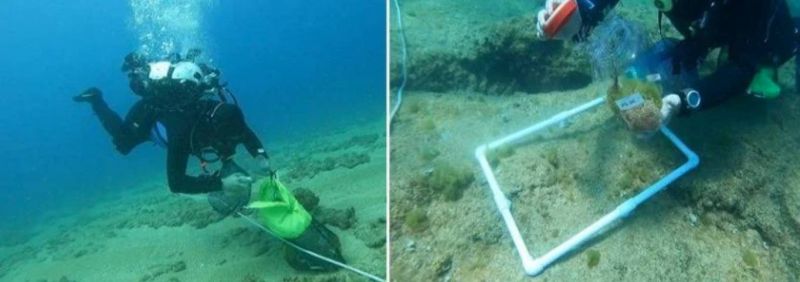
CNRS researchers diving for samples. (Credit: CNRS-L)
The obvious link between pollution and the decline of biodiversity in Lebanon was compounded in a recent coastal monitoring study carried out by the National Center for Marine Sciences at the National Council for Scientific Research.
The research took samples from two protected sites, the Tyre Coast Nature Reserve in Southern Lebanon, and the Palm Islands Nature Reserve off the coast of Tripoli, as well as the Beirut coastline.
The cross-comparison established that Beirut is less rich in marine biodiversity than the protected areas.
National Council scientists Sharif Jomaa and Celine Mahfouz spoke to L’Orient-Le Jour about the initial results of the study, which is set to continue for several years and is part of the EcAp MED project, financed by the European Union and carried out by the Environment Ministry.
Q- What are the benefits of the study’s use of comparative methodology between regions?
A- It was important to see whether marine biodiversity actually decreases when there is pollution, and in what way, and whether it is spared in protected areas. To do this, our researchers dove to 10, 20, and 30 meters deep because marine biodiversity differs depending on depth, and within a 100-meter radius of the coast. During the dive, they took samples, photos, and videos.
We focused mainly on non-native fish species, those that reached our shores since the opening of the Suez Canal and its expansion. These species are acquiring increasing socio-economic importance on the Lebanese market, many of which are fit for consumption. They are nonetheless a threat to indigenous species.
Q- What are the preliminary results of the first phase of the study?
A- We found many more species in the protected areas than in Beirut, which suggests that pollution has a direct impact on the quantity of fish and the diversity of species. The other result is that the biodiversity recorded in Sour is somewhat richer than on the Palm Islands (near Tripoli). On this last point, we don’t yet have all the information we need to understand why this is the case. It may depend on the nature of the subsoil or other factors, which will require closer examination in the years to come.
Q- What impact does pollution have on edible fish?
A- The study looked at samples of fish and rock mussels, some of the most commonly consumed species in Lebanon, including red mullet (Sultan Ibrahim), Little Tunny and Sargo. The analyses showed that, generally speaking, these fish do not contain any worrying concentrations of heavy metals (cadmium, mercury and lead) or organic pollutants, and that the levels remain within the EU Commission recommended standards.
Our findings show that the fish are safe to eat, even those which, because of their habitat (close to the coast or in contact with sub-sea sediments) or their large size, are more likely to absorb pollutants than others.
These results show that, despite the poor reputation of the Lebanese coastline when it comes to pollution, this pollution does not have a dangerous effect on fish because it is mainly bacteriological (coming from wastewater), and does not have as much potential to accumulate in tissues as the chemical pollution that is much less present in Lebanese waters.
This article was originally published in French in L'Orient-Le Jour. Translation by Joelle El Khoury.